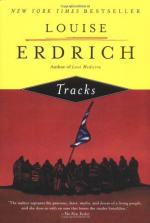|
This section contains 4,789 words (approx. 16 pages at 300 words per page) |

|
SOURCE: "The Fragmentation of a Tribal People in Louise Erdrich's Tracks," in American Indian Culture and Research Journal, Vol. 17, No. 2, 1993, pp. 1-13.
In the following essay, Larson discusses Erdrich's depiction in Tracks of Native Americans' loss of land and cultural identity to white colonization.
Louise Erdrich's novel Tracks deals with the years between 1912 and 1919, when the North Dakota Chippewa, or Anishinabe, as they call themselves, were coping with the effects of the General Allotment Act of 1887, the purpose of which was to divide tribally allotted lands among individual Indians so that these Indians could leave their nomadic, communal cultures behind and become settled as farmers. After the Indian Allotment Act of 1904, each enrolled member of the Turtle Mountain Chippewa born before 1909 received one quarter section of land, with single members of the tribe receiving various lesser amounts depending on their age. This was part of the transformation of...
|
This section contains 4,789 words (approx. 16 pages at 300 words per page) |

|


